
Restrictions
-
Be made for 2 players
-
Have rules that fit on a single printed page
-
Have one additional single printable page that contains the game board and all pieces
-
May use Pawns (checkers, beads, etc.)
-
-
Use only up to 2D6 (two six-sided dice) and no other form of randomization
-
May choose to use a single D6, or 2D6 per player
-
No cards, spinners, coin flips, or any other form of randomization.
-
-
Be more based on skill than luck
-
Take less than 30 minutes to play, including setup.
What Went Right
Pushing and Shoving
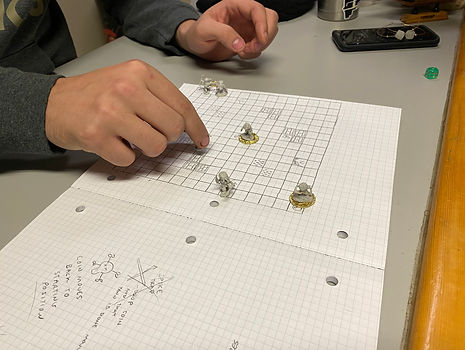
One of the mechanics of my board game was the ability to push opponent pieces away in a straight line from the controller's pawn. This feature received great reception from play testers as it allowed for both offensive and defensive plays, as well as just being generally fun. Players used the mechanic to push opponent pieces into pits, which would reset the affected pawn to its starting area, and into and out of the path of flag carriers; pawns are unable to move through each other.
Modular Board
During one of the last play tests, a play tester set up the board in an unintended fashion; it followed the outlined rules and led to a tense finish. A section of the board (pictured here, particularly in the bottom left and top right) was originally designed to home the tokens meant to be captured, instead during this particular game they were chosen as the starting areas. After two flags had been captured, a frantic scramble ensued over the final flag, due to the limitations of the pathways to these areas players had to plan out their routes to prevent blocking themselves from scoring and stop their opponent from utilizing it to steal the flag. Additionally, the pit area, represented by the shaded portion, meant misplacing a pawn that could be pushed and reset would give a player one less resource for at least one turn.
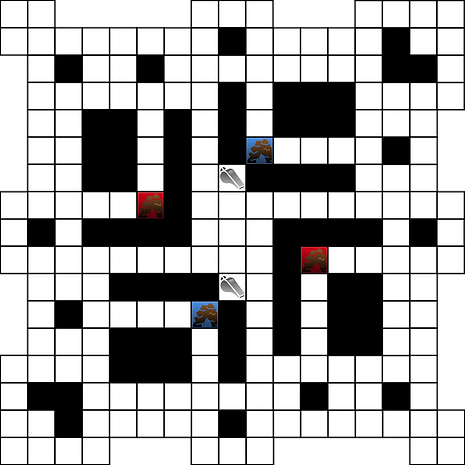
ROLL OFF!
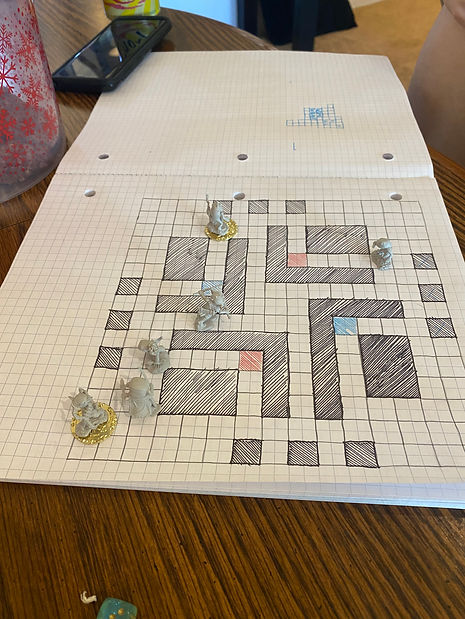
Initially, the idea for flag stealing was a player's pawn would move into a space occupied by an opponent flag carrier, they would take the flag place the opponent's pawn in an adjacent space then finish their movement. However, during the final playtests I tried some major changes, one of which was "battling" for the flag by having both players roll their die; whoever rolled the higher number "won". While I wasn't crazy about the idea, due to it relying on luck rather than skill, play testers loved the idea of a roll off. Ultimately, I decided to keep the feature as it provided a high risk, high reward mechanic; players would have to choose to spend a pawns turn attempting to steal a flag, failure would mean one less resource on their turn.
What Went Wrong
Lady Luck
One thing I wanted to avoid in my design was luck determining a winner; I wanted it to be a battle of skill. Unfortunately, as dice rolls determined how many spaces each pawn could move on a player's turn, it was hard to get away from. During the final string of play tests, I implemented a set amount of moves for each player, leaving dice rolls for flag stealing, but play testers didn't like this idea. When I asked what it was about it that they didn't like, the simple answer was that it wasn't fun. So, while it placed both players on an even field and didn't give a player with bad rolls a disadvantage, it didn't resonate with the play testers and was scrapped.

Special Movement

While I was brainstorming ideas for what would eventually become Battle of the Bored, I had an idea where pawns had additional means of movement. These ideas included picking "classes" for each pawn, which included a knight, a mage, an archer and a thief. Each class had a unique style of movement: Knights would halve their movement but required two attempts to have a flag stolen from them, Mages could attack an opponent's pawn from range but couldn't carry a flag, Archers could also attack from range and if they occupied the same space for two turns, they would double their attack range, Thieves were able to perform a one space sidestep at the beginning of their turn and then preform their regular movement. All of these were deemed too complicated to implement and were canned during the early stages of development.
Where's the Backup?
I wanted to implement a way for pawns to be defeated without taking them out of the game, which would prevent a player from losing their pieces and feeling helpless. My design idea was, if a pawn couldn't be placed into a valid adjacent square when a flag was being stolen, or if they were pushed into a pit, they would be reset to their starting area. On paper, this seemed like a great way to keep both players resources balanced and force them to think about placement; foolishly rushing in would be met with punishment and strategic moves would be rewarded. However, when a player was threatening to score and defeated an opponent's pawn, that pawn was essentially a lost resource. Low dice rolls meant a defeated pawn took too many turns to get back into the action, this typically resulted in players abandoning them altogether. I brainstormed a few ideas that would mitigate this issue but had problems finding a solution. I tried adding special spaces that allowed pawns to traverse the board or allowed other pawns to recall defeated ones, but both designs had their flaws. This is still an area of focus to make Battle of the Bored fun, competitive and engaging.
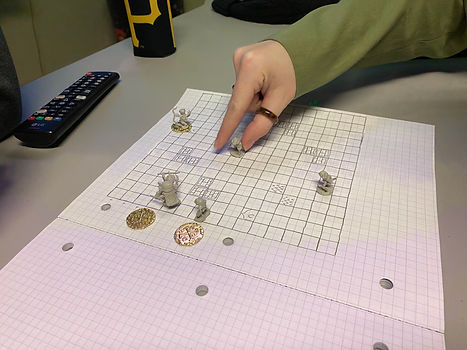
Conclusion
My inspiration for Battle of the Bored stemmed from the tabletop game Heroclix and the Disgaea video game franchise. It was challenging to create a game that was enjoyable and intuitive, without directly taking from an established board game. I liked the idea of capture the flags for the core mechanic, but I wanted to add twists that made it more unique. It was a learning process balancing each new feature and trying to take luck out of the equation as much as possible, but still make the game fun. I tried to avoid complexity and focus on simple mechanics, while ironing them out before moving on to the next idea. I still have a lot to learn when it comes to balancing, but I was happy with how the core gameplay came out. I learned that a balanced game doesn't necessarily make it fun; sometimes luck is more exhilarating.
Project Photos
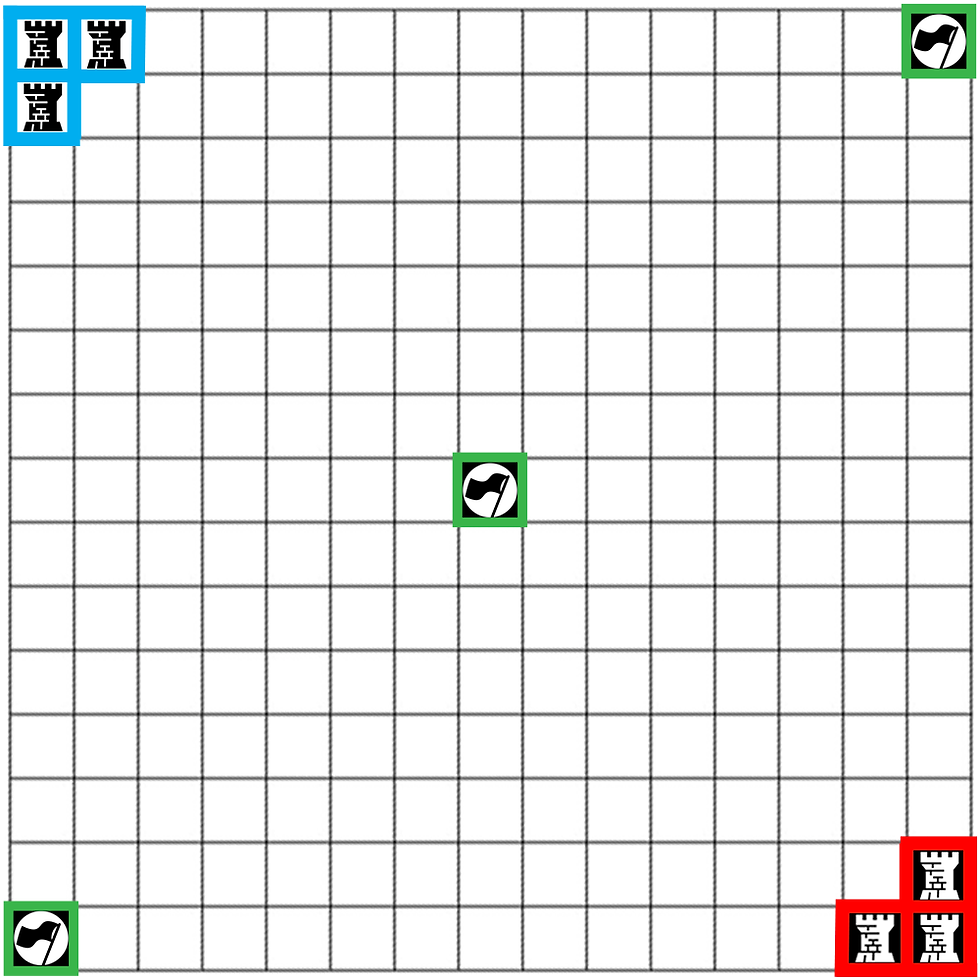
First iteration of the game board. At this stage, players raced to capture 2 flags before their opponent. Heavily relied on luck.

Second iteration of the game board. Walls couldn't be walked through, spikes caused pawns to be reset, and tunnels allowed pawns to traverse the board. Spikes were never used as players saw no reason to be near them.

Before adding the whistle space, a defeated pawn could be recalled by a friendly pawn, but both were unable to move that turn. Tried implementing set movement amount, but dice rolls were preferred.

First iteration of the game board. At this stage, players raced to capture 2 flags before their opponent. Heavily relied on luck.



